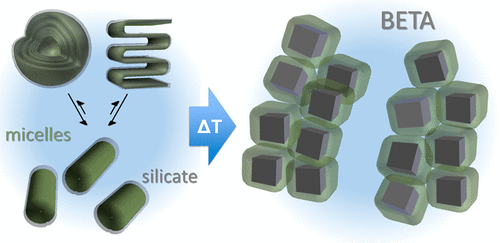当前位置:
X-MOL 学术
›
Chem. Mater.
›
论文详情
Our official English website, www.x-mol.net, welcomes your feedback! (Note: you will need to create a separate account there.)
Unraveling Direct Formation of Hierarchical Zeolite Beta by Dynamic Light Scattering, Small Angle X-ray Scattering, and Liquid and Solid-State NMR: Insights at the Supramolecular Level
Chemistry of Materials ( IF 8.6 ) Pub Date : 2018-03-12 00:00:00 , DOI: 10.1021/acs.chemmater.8b00109 Maria Castro 1 , Pit Losch 1 , Woojin Park 2 , Mohamed Haouas 3 , Francis Taulelle 4 , Claudia Loerbroks 1 , Gert Brabants 4 , Eric Breynaert 4 , Christine E. A. Kirschhock 4 , Ryong Ryoo 2 , Wolfgang Schmidt 1
Chemistry of Materials ( IF 8.6 ) Pub Date : 2018-03-12 00:00:00 , DOI: 10.1021/acs.chemmater.8b00109 Maria Castro 1 , Pit Losch 1 , Woojin Park 2 , Mohamed Haouas 3 , Francis Taulelle 4 , Claudia Loerbroks 1 , Gert Brabants 4 , Eric Breynaert 4 , Christine E. A. Kirschhock 4 , Ryong Ryoo 2 , Wolfgang Schmidt 1
Affiliation

|
A case study on the understanding of the formation of hierarchical Beta zeolites using gemini-type piperidine based multiammonium surfactant (N6-diphe) is reported. Complementary techniques were used to investigate N6-diphe’s structure-directing effect at the molecular level. Combining characterization of the resulting zeolite materials with the toolboxes herein developed for studying clear solutions and dense gels discloses self-assembly processes that govern the growth (and growth inhibition) of nano-Beta zeolite crystals. In clear solution, small-angle X-ray scattering and liquid-state NMR provide insights about the formation of nanoparticles and their degree of order. 14N and 1H-DOSY NMR probe the dynamics and mobility of soluble species. In a dense gel, on the other side, 27Al- and 29Si-(MAS) NMR elucidate the varying local connectivity between initial nano-objects and the final solid products. It has been found that cylindrical micelles control the transformation of solubilized silica and alumina during the formation of zeolite nuclei and guide their crystal growth to nano-Beta rods with bimodal mesoporosity. The predominant smaller mesopores (6 to 8 nm) originate from the template’s hydrophobic alkyl chains, while larger mesopores (10 to 30 nm) are supposed to result from a spinodal decomposition-type segregation of phases consisting of as-formed hydrophobic zeolite rods and an aqueous solution.
中文翻译:

通过动态光散射,小角度X射线散射以及液态和固态NMR揭示分层沸石β的直接形成:超分子水平的见解
报道了一个关于使用双子型哌啶基多铵表面活性剂(N 6 -diphe)理解形成分级β沸石的案例研究。互补技术用于研究分子水平上的N 6 -diphe的结构指导作用。将所得沸石材料的特性与本文开发的用于研究透明溶液和致密凝胶的工具箱相结合,揭示了控制纳米贝塔沸石晶体生长(和生长抑制)的自组装过程。在透明溶液中,小角X射线散射和液态NMR可提供有关纳米颗粒形成及其有序度的见解。14 N和1H-DOSY NMR探测可溶物质的动力学和迁移率。另一方面,在致密的凝胶中,27 Al和29 Si-(MAS)NMR阐明了初始纳米物体与最终固体产物之间的局部连通性。已经发现,圆柱状胶束在沸石核形成过程中控制着溶解的二氧化硅和氧化铝的转化,并引导它们的晶体生长到具有双峰介孔性的纳米贝塔棒中。较小的中孔(6至8 nm)主要来自模板的疏水性烷基链,而较大的中孔(10至30 nm)被认为是由于旋节线分解型相分离而形成的,该相由刚形成的疏水性沸石棒和水溶液。
更新日期:2018-03-12
中文翻译:

通过动态光散射,小角度X射线散射以及液态和固态NMR揭示分层沸石β的直接形成:超分子水平的见解
报道了一个关于使用双子型哌啶基多铵表面活性剂(N 6 -diphe)理解形成分级β沸石的案例研究。互补技术用于研究分子水平上的N 6 -diphe的结构指导作用。将所得沸石材料的特性与本文开发的用于研究透明溶液和致密凝胶的工具箱相结合,揭示了控制纳米贝塔沸石晶体生长(和生长抑制)的自组装过程。在透明溶液中,小角X射线散射和液态NMR可提供有关纳米颗粒形成及其有序度的见解。14 N和1H-DOSY NMR探测可溶物质的动力学和迁移率。另一方面,在致密的凝胶中,27 Al和29 Si-(MAS)NMR阐明了初始纳米物体与最终固体产物之间的局部连通性。已经发现,圆柱状胶束在沸石核形成过程中控制着溶解的二氧化硅和氧化铝的转化,并引导它们的晶体生长到具有双峰介孔性的纳米贝塔棒中。较小的中孔(6至8 nm)主要来自模板的疏水性烷基链,而较大的中孔(10至30 nm)被认为是由于旋节线分解型相分离而形成的,该相由刚形成的疏水性沸石棒和水溶液。



























 京公网安备 11010802027423号
京公网安备 11010802027423号